Breathtaking Brittany
Pick up a favourite footpath at sensational spots around Brittany’s coast to make the most of the beautiful scenery and rich heritage.
"We found awe-inspiring sights – sand yachts racing, cormorants drying their wings and a glittering rock pool teeming with ocean life"
- Carol Kubicki
Words & photography courtesy of Carol Kubicki
Flowering Finistère
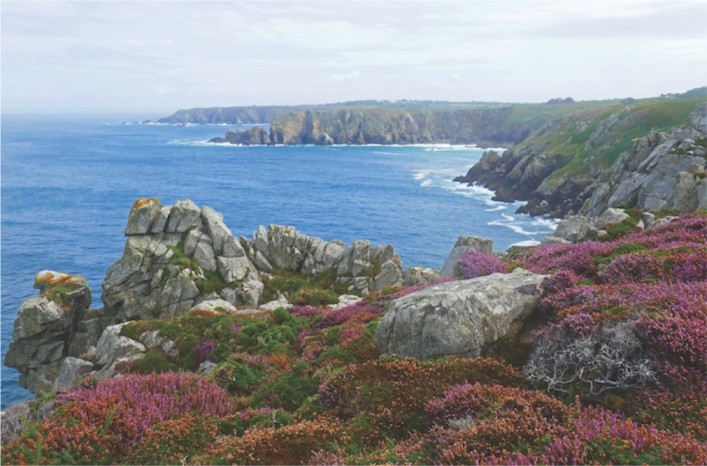
A popular bumper sticker in the French department of Finistère in western Brittany is ‘Tout commence en Finistère’ (everything starts in Finistère). The name Finistère implies the end of the earth and, feeling the wind in my hair in this awe-inspiring spot, I caught a glimpse of endings and beginnings.
The sweet smell of flowering heather mingled with the tang of salt as I turned south along the coastal footpath to the scenic cliffside chapel, the Pointe du Raz looming beyond. The idyllic Baie des Trépassés (bay of the dead) huddles between these two mighty headlands, the bay so named because of the bodies that washed up here from shipwrecks.
We had landed in Saint-Malo – Brittany Ferries operates the Portsmouth to St Malo route – and headed west towards Finistère, only distracted by Ploumanac’h for a hot tip about ice cream.
Strolling the Sentiers
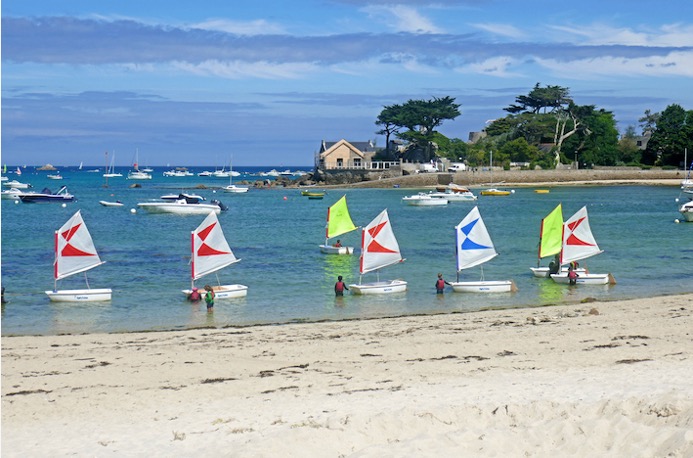
As well as delicious cornets, Ploumanac’h introduced us to the GR34, France’s favourite long-distance footpath that hugs the Brittany coast (and a tiny bit of Normandy) for nearly 2,000km (1,243 miles). It stretches from Mont-Saint-Michel to Saint-Nazaire. Known as the Sentier des Douaniers, the GR34 was created in the eighteenth century to closely follow the coast and help customs officers catch smugglers.
Driving through Finistère’s farming landscape, the roads were pleasurably quiet. We chanced upon the delightful Brignogan-Plages, a charming village in a sheltered bay lined with mansions, and so began our morning beach stroll and coffee habit.
Under a blue sky and reunited with the GR34, we paddled through the clear water, tiny fish swimming around my toes. Feeling in heaven, we drank our coffee while watching a group of children learning to sail. I wanted to cheer when they marshalled their small yachts into line.
At Camping du Vougot, near Guissény, we were shown to the largest pitch we have ever encountered. Lined with trees and hedges, we shared the space willingly with throngs of birds and the large beach nearby delivered dramatic sunsets; I knew I was falling in love with Finistère.
Ten minutes’ walk inland, we explored the ponds and marshes of a nature reserve that teemed with flowers and wildlife.
The GR34 climbs the dyke that protects these wetlands and we strolled with the sea to one side and reed-lined ponds to the other.
A rugged coast
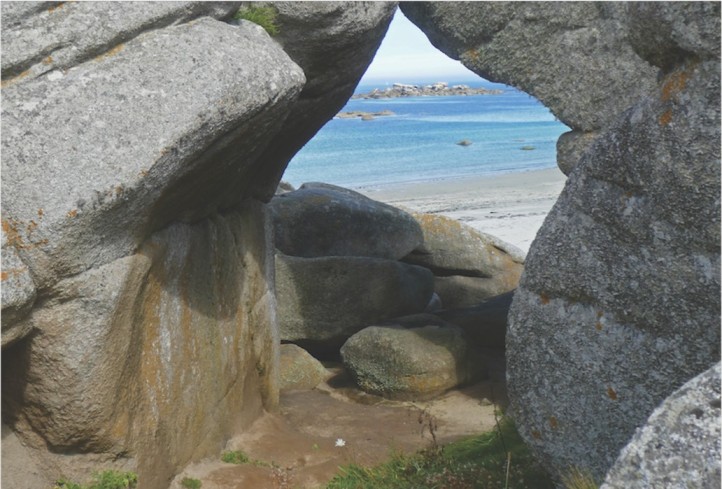
Lanes along which we cycled meandered between attractive bays and headlands. Known as the Pays Pagan (Pagan Country), this part of Finistère is the setting for many legends. With craggy reefs crouching below the waves, difficult currents and sea mists, stories of shipwrecks abound. In the nineteenth century the people of these isolated communities were accused of being more interested in looting from shipwrecks than saving sailors’ lives.
Rounding a headland onto the exposed northern coast, we stopped to watch surfers catching the waves. Sheltered coves were thick with the glistening seaweed that has long been gathered for fuel, fertiliser and food. Our lunch was eaten on a promontory beside a memorial to a Canadian boat torpedoed in 1944, while looking over white sands where massive rounded boulders leaned against each other, making surreal shapes.
On the rugged cliffs of Pointe Saint-Mathieu a red and white lighthouse towers over the ruins of an abbey, weaving together different histories of this perilous and productive coast. Of course, the GR34 comes this way and its red and white markers took us along the cliffs, passing WWII German defences and display boards with lists of ships and submarines that have been lost here. At the sombre National Memorial to Sailors, we watched yachts navigating a safe course between the rocks.
Fortified France
Fort de Bertheaume, an island fort reached by steps and bridges, is nearby. Fortified by Vauban in the seventeenth century, the fort faces Vauban’s tower in Camaret-sur-Mer to the south, both guarding the Goulet de Brest, the narrow strait between Brest and the ocean.
There has only been a bridge to the fort since 1817. Before then an aerial gondola was used and, these days, you can recreate that excitement by zip wire. We chose the bridge to reach the spectacular view from the fort and watched a succession of excited people swinging high above the waves. The fort was used by the Germans in WWII and I was horrified to read that it wasn’t cleared of mines and opened to the public until the 1990s.
Crazy about Crozon
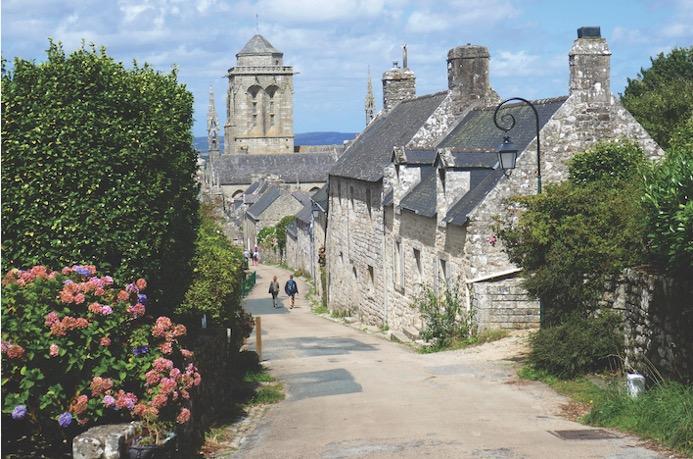
The Finistère coastline is a series of craggy peninsulas. As we both enjoy bracing walks along windswept cliffs, we weaved a serpentine route around them. On the Crozon peninsula we explored the appealing town of Camaret-sur-Mer, from the narrow backstreets where bougainvillea trailed prettily overhead to the busy harbour lined with stylish restaurants. From the port we wandered along the shingle spit, passing the eerie wrecks of the boat graveyard.
Scoured by salty waves, the exposed Notre-Dame de Rocamadour chapel has a delightful interior with model boats hanging from the ceiling. Beyond the chapel is the striking ochre-coloured seventeenth century Vauban Tower.
The following day we headed to the Baie de Douarnenez and, as seemed to be the norm all along Brittany’s magnificent shores, we found something awe-inspiring – sand yachts racing, cormorants drying their wings and a glittering rock pool teeming with ocean life.
Inland we visited the picture-perfect grey-stone village of Locronan during one of the town’s enticing night markets when stalls selling local food and crafts line the narrow, cobbled streets and the medieval stone buildings are lit up by the setting sun and colourful lights. A pipe and drum band marched through the throng and played on the church steps and a harpist plucked in a quieter corner.
An audience with Audierne
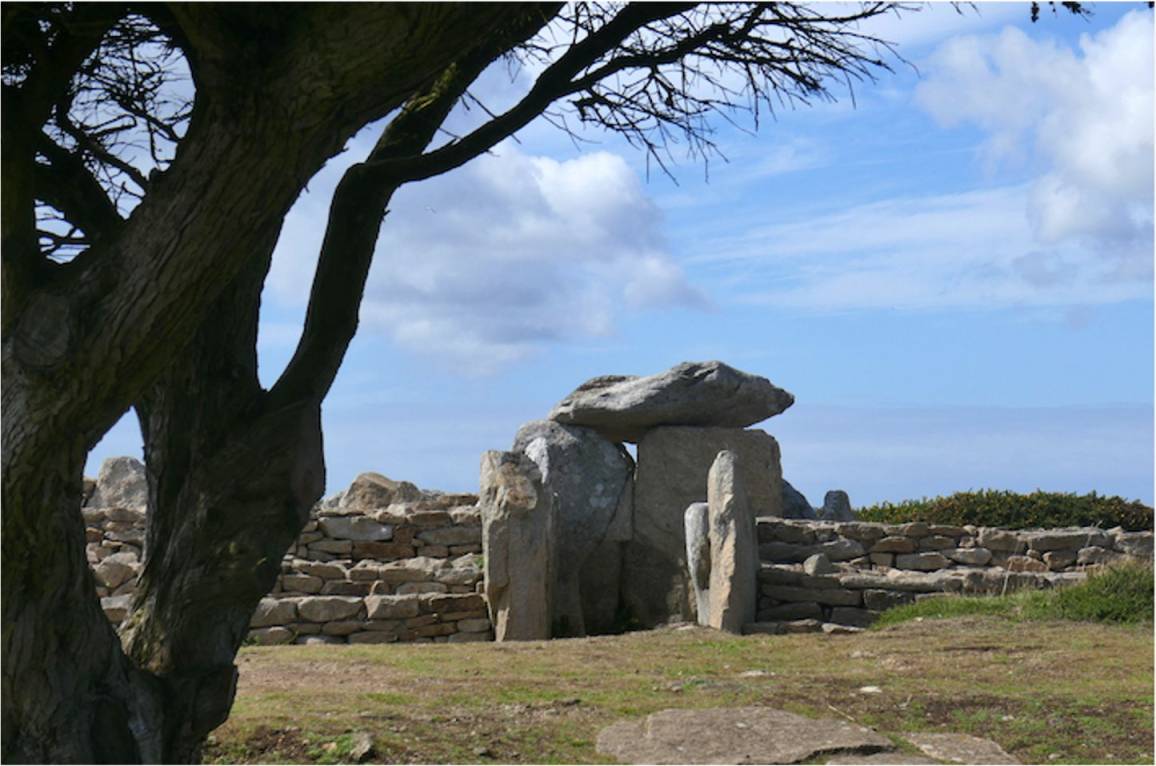
On the Cap Sizun peninsula we cycled to the attractive fishing town of Audierne, where dazzling white buildings line the pretty harbour. Fortuitously, we spotted the signs for the Parc Botanique Ar Paeron and made the effort to climb the steep hill and enter. We seemed to have the meandering paths of this colourful botanical garden to ourselves and, after the lively beaches, the peace was perfect.
From la Pointe du Souc’h the views encompass the length of the Baie d’Audierne. We had come here to see the ancient sites of Menez Dregan, mostly on grassy lanes lined with fragrant bushes, the lush landscape tumbling down to the jagged coastline.
The oldest site here is a cave used 465,000 years ago in the Palaeolithic period when sea levels were lower and the cave overlooked grassland. More recent is Menez Dregan’s fascinating large and complex Neolithic necropolis.
Emerald coastal paths
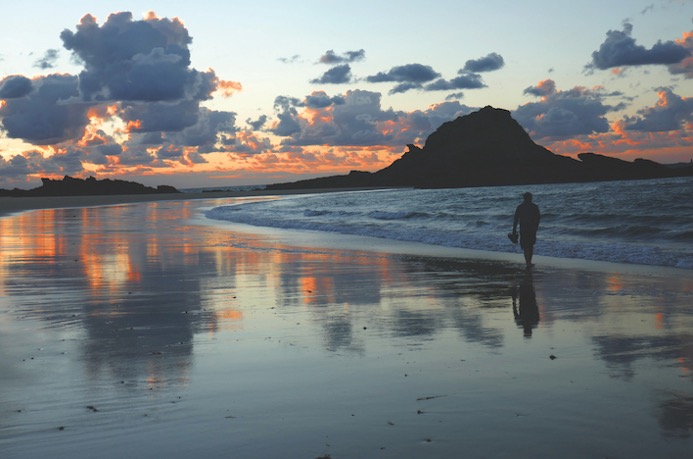
My appreciation for Brittany may have begun on a breezy cliff; however, the coastline near Saint-Malo – known as the Côte d’Émeraude (Emerald Coast) – sent me home truly smitten. Here we found secluded coves, rugged headlands and some unusual carvings.
Camping des Chevrets sits between two promontories divided by the sandy crescent of Plage des Chevrets and the sheltered bay of Rothéneuf Harbour. Rock samphire and purple sea lavender grew abundantly among the crags and wading birds fed on salt marshes at low tide.
During the day, paragliders launched themselves from the grassy hillside above the beach and, in the evenings, spectacular sunsets wowed us.
Sculptural coast
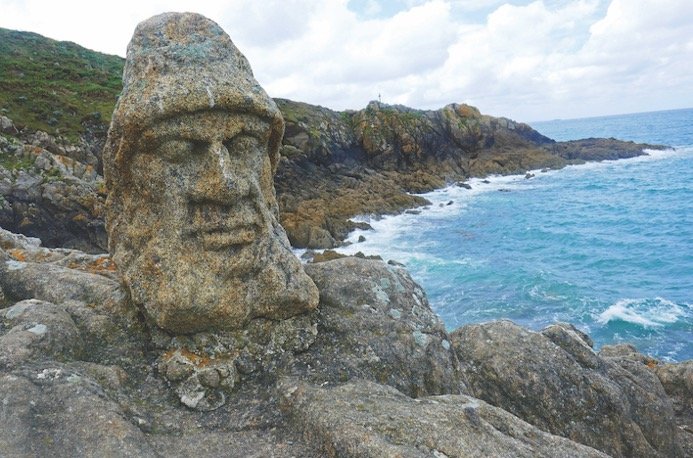
The GR34 to Rothéneuf has low and high tide options, so, while we could cross the sands and a crumbling walkway over the river on our way out, on our return we skirted through the trees above the beaches.
Beyond Rothéneuf we found a cliffside chapel and descended precipitous steps to a tiny cove.
A short distance further we reached the amazing Rochers Sculptés, over 300 sculptures on a sloping cliff (created by a priest between 1894 and 1910).
With no safety rails, getting around the footways between the intertwining clusters of figures and animals can be tricky as you never lose sight of the sea crashing against the rocks just below.
Waiting for the ferry home
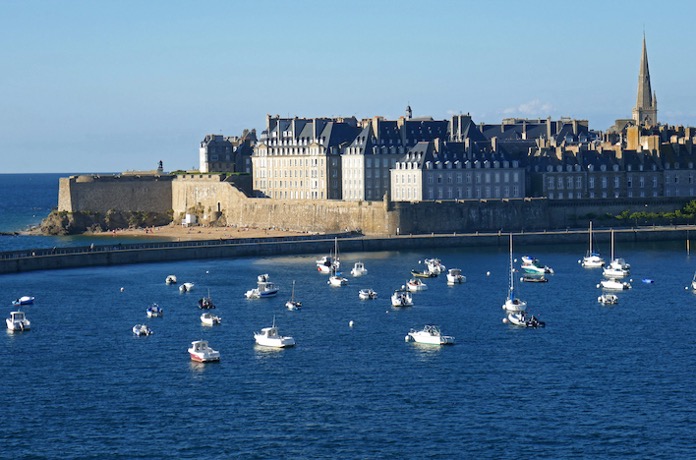
It often happens that our last walk is our best. The coastal path took us to Pointe du Grouin, where the spectacular views included Mont-Saint-Michel shimmering in the far distance.
This rugged shoreline has enough little bays for everyone and the GR34 descends to each one and climbs back up to cliffs of lichen-covered coarse rock. Between the coves we were shaded by fragrant pine trees. Hordes of butterflies flew among the wildflowers that flourished on sunny stretches.
We rejoined other holidaymakers as we crossed the stretch of soft sand at Île de Guesclin, which ends at a tidal island with an eighteenth century fort.
Before catching our ferry home, we visited St Malo, ticking off another short section of the GR34 along its ramparts.
We had our last crêpes of the trip in a shady square of the walled city and reminisced about our Brittany highlights. It took a while to brush all the sand out of our belongings when we returned home, each grain bringing back a memory of the Sentier des Douaniers – and the beautiful scenery and rich heritage of Brittany.
Brittany Ferries
When you say Oui to Brittany Ferries, France comes to life the moment you set sail. With space to relax and unwind and award-winning on-board restaurants, there are plenty of reasons to choose Brittany Ferries. Hitch up your caravan and get ready to head off; sailing over by ferry makes it easy.
Free Flexible Ticket upgrade
With a Free Flexible Ticket upgrade (T&C’s apply – see website for details) and low deposits there’s never been a better time to book. Book by 28 February and say Bonjour to France!
Perfect ferry crossings and advice on the area:
brittany-ferries.co.ukGet away from it all:
brittanytourism.comDiscover the flora from five continents:
parcbotaniquearpaeron.frWhat do you want of Finistère:
toutcommenceenfinistere.comPrices couple, electric hook-up, per night
Camping des Chevrets
38 Rue de La Guimorais,
35350 St-Coulomb
0033 299 890190
7 April – 9 October
From €26.70 (£23.98)
Camping du Vougot
1037 Route de Prat Ledan,
Lieu-dit Le Vougot,
29880 Plouguerneau
0033 763 525544
29 April – 23 September
Two adults, pitch and electric: From €23.95 (£21.51)
Camping Tourony
105 Rue de Poul Palud,
22730 Trégastel
0033 296 238661
9 April – 24 September
From €19.20 (£17.25)
Get Caravan magazine from just £19.99

Caravan magazine has been inspiring caravanners for more than 80 years! Every monthly issue is packed with caravan travel inspiration, the best sites to stay on, caravan road tests, reviews and buying guides, plus top technical advice.
Caravan’s fully searchable digital library gives you access to the latest issues, plus every edition of Caravan since February 2013.
Expert Caravan advice to your door!

Caravan magazine has been inspiring caravanners for more than 80 years! We have grown to become a leading authority on caravans, the caravan industry, caravan lifestyle, campsites and caravan travel destinations. We know what our readers want – and that's to make the most of their caravans and their holidays!
Want to know more about Caravan magazine?
About Caravan magazine








Recent Updates
Caravanning with dogs: all you need to know
Caravan holidays with dogs are a joy for lots of reasons. Firstly, many people choose to buy a caravan specifically because they have a dog – or more ...
Caravan showers: all you need to know
In this guide, we’ll discuss the different types of showers, how they work, and how to fit an external shower ...
Caravan towing: all you need to know
Towing a caravan may seem daunting initially, but a few simple tips can make the journey enjoyable and ...
All you need to know about towbars & towballs
Flange, detachable, swan neck, retractable – towbar technology choice is bewildering. Don’t worry. We’ll ...
Caravan WiFi: everything you need to know
Caravan holidays are the ultimate way of getting away from it all, although we sometimes need a link to the ...
Caravan insurance: all you need to know
Navigating the world of caravan insurance can feel like a daunting task. Fear not, as this comprehensive ...
Buying a caravan: what you need to know
Let us guide you through some of the complicated things to think about when first looking at buying a ...
Caravan awnings: a buyers' guide
Caravan awnings are a fantastic addition to any caravan as they are one of the simplest, quickest and most ...
Caravan electrics: avoid tripping out
All caravan owners have overloaded their mains supply at some time. Here’s how to master caravan electrics ...
Caravan heating systems: a quick guide to caravanning warmth
When winter is here, you’ll be glad of a decent caravan heating system if you’re out touring. Here’s how the ...
Other Articles
Caravan damp: a complete guide
There's little more guaranteed to strike fear into the heart of a caravan owner than the word 'damp'. But if you keep on top of it, and spot it ...
Caravan jockey wheels: the definitive guide
A well-functioning caravan jockey wheel can make all the difference to manoeuvring away from the towcar, ...
Caravan cooking recipes
Caravan cookery inspirational ideas. No need to stress out in the kitchen with these quick and easy ...
Caravan bike racks: a complete guide
Exploring the beautiful surroundings while on a caravan trip is undeniably one of the greatest joys of the ...
Caravan solar panels: all you need to know
Whether you dream of roaming off-grid or just fancy reducing your carbon footprint, fitting solar panels to ...
The ultimate guide to caravan layouts
Choosing the right layout or floorplan of your caravan is an all-important part of the buying process – find ...
A guide to seasonal caravan pitches
Our in-depth guide to finding and securing seasonal caravan pitches on your favourite campsite ...
Caravan weights and payloads: a quick guide
The terminology of caravan weight – MIRO, MTPLM, noseweight, kerbweight, payload, weight plate upgrade – is ...
The ultimate guide to caravan motor movers
Caravan motor movers: everything you need to know about remote control caravan manoeuvring ...
Caravan cleaning: All you need to know
Whether you’re taking the caravan out for the first time or it’s just in need of a spruce up, our guide will ...